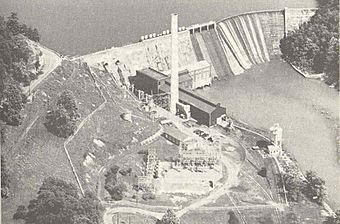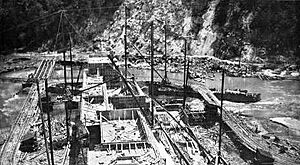Ocoee Dam No. 1 facts for kids
Quick facts for kids |
|
|
Ocoee No. 1 Hydroelectric Station
|
|

Ocoee Dam No. 1, 1940s
|
|
| Location | Polk County, Tennessee |
|---|---|
| Built | 1910-1911 |
| Architect | J.G. White, W.P. Creager |
| NRHP reference No. | 90001003 |
| Added to NRHP | 1990 |
The Ocoee Dam Number 1 is a large hydroelectric dam on the Ocoee River in Polk County, Tennessee. This dam creates the 1,930-acre (780 ha) Parksville Reservoir, also known as Ocoee Lake. It is the first of four dams on the Toccoa/Ocoee River that are owned and run by the Tennessee Valley Authority (TVA). Ocoee No. 1 was finished in 1911. It was one of the very first projects in Tennessee to produce electricity using water power.
Contents
Where is Ocoee Dam No. 1 Located?
Ocoee Dam No. 1 is about 12 miles (19 km) from where the Ocoee River flows into another river. This area is where the Ocoee River leaves the Appalachian Mountains and enters the Tennessee Valley. The small town of Parksville is right next to the dam on its north side. The city of Chattanooga is about 30 miles (48 km) to the west.
The Ocoee Scenic Byway, which is part of U.S. Route 64, goes just north of the dam. Parksville Lake stretches for several miles east along the Ocoee River. It also goes south along Baker Creek, which used to flow into the Ocoee River near the dam. Another dam, Ocoee Dam No. 2, is located a bit more than 12 miles (19 km) upstream from Ocoee No. 1.
How Big is Ocoee Dam No. 1?
Ocoee Dam No. 1 stands 135 feet (41 m) tall and is 840 feet (260 m) long. It can produce 24,000 kilowatts of electricity. This is more than its original 19,200 kilowatts. The dam was updated between 1989 and 1991 to make more power.
The dam has a special concrete overflow area called a spillway. This spillway can release up to 45,000 cubic feet per second (1,300 m3/s) of water. Parksville Lake has 109 miles (175 km) of shoreline. The water level in the lake changes by only about 9 feet (2.7 m) each year.
History of Ocoee Dam No. 1
In the late 1800s and early 1900s, industries in Chattanooga grew very fast. This meant they needed a lot more electricity. The Ocoee River, which flows quickly through a mountain gorge, was perfect for making hydroelectric power. It was about 30 miles (48 km) east of Chattanooga.
In 1910, a company called C.M. Clark Company created the Eastern Tennessee Power Company. Their goal was to build two hydroelectric dams on the Ocoee River. They planned to sell the electricity mainly to Chattanooga. Work on Ocoee Dam No. 1 started in 1910 and was finished in December 1911. On January 27, 1912, the dam's first four power units began working. A fifth unit was added in 1914. Together, these units could produce 18 megawatts of power. This power went mostly to Chattanooga. It also went to Knoxville, Nashville, and Rome, Georgia. The aluminum factories in Alcoa also used this power.
A power plant that burned coal, called the Parksville Steam Plant, was built next to the dam in 1916. This plant helped make electricity when the river's water levels were low. It was last used in 1954.
In 1922, the Eastern Tennessee Power Company joined with other companies to form the Tennessee Electric Power Company (TEPCO). TEPCO updated Ocoee No. 1 in the 1930s. In 1933, the TVA Act was passed. This law created the Tennessee Valley Authority (TVA). The TVA was given control over the Tennessee River area, which includes the Ocoee River.
The head of TEPCO, Jo Conn Guild, did not like the idea of TVA. With the help of a lawyer named Wendell Willkie, he went to court. They argued that the TVA Act was against the law. However, the U.S. Supreme Court decided in 1939 that the TVA Act was legal. This decision was called Tennessee Electric Power Company v. TVA. Because of this, TEPCO had to sell its properties to TVA. On August 16, 1939, TVA bought TEPCO's assets for $78 million. This included $2.68 million for Ocoee Dam No. 1.
Images for kids





